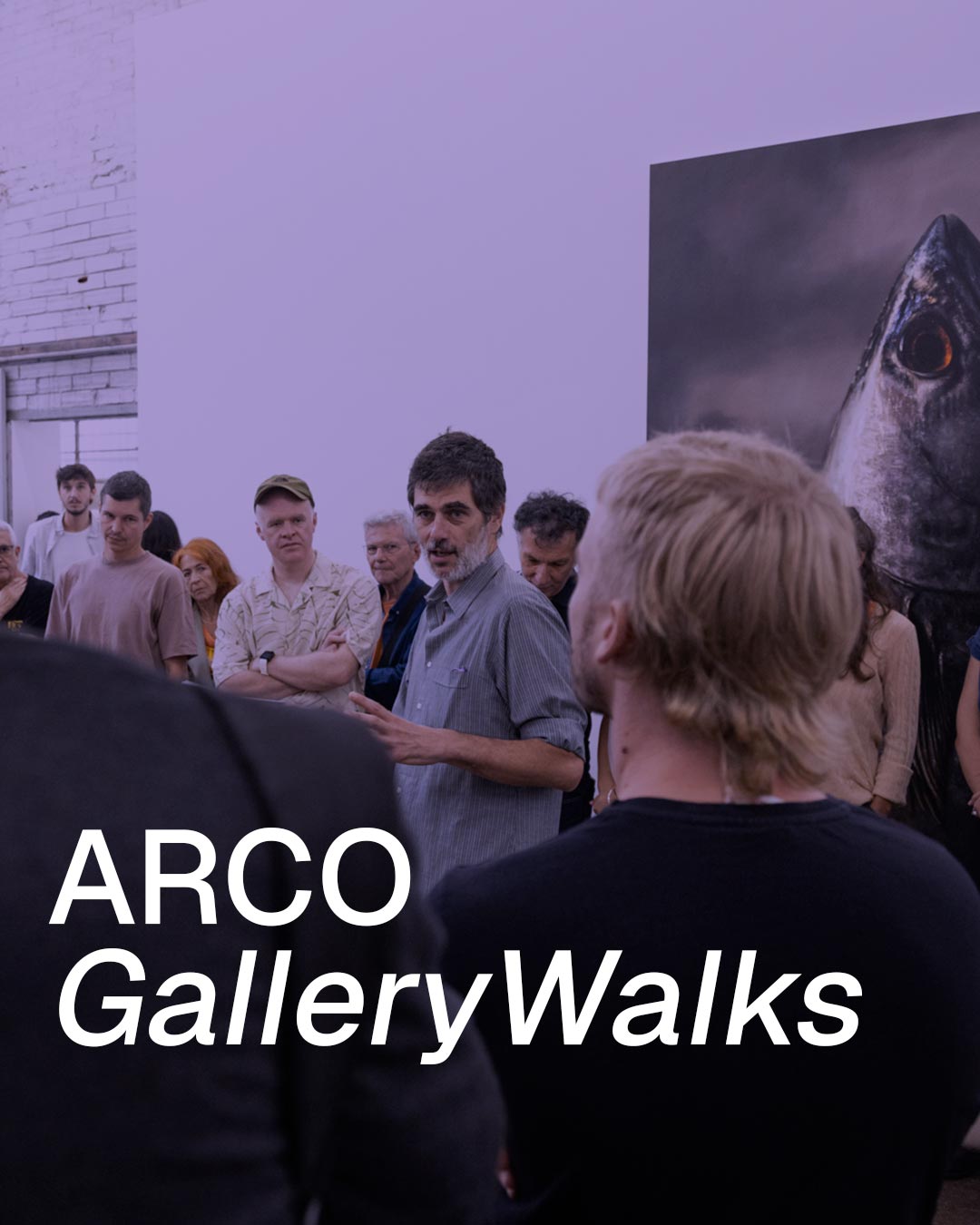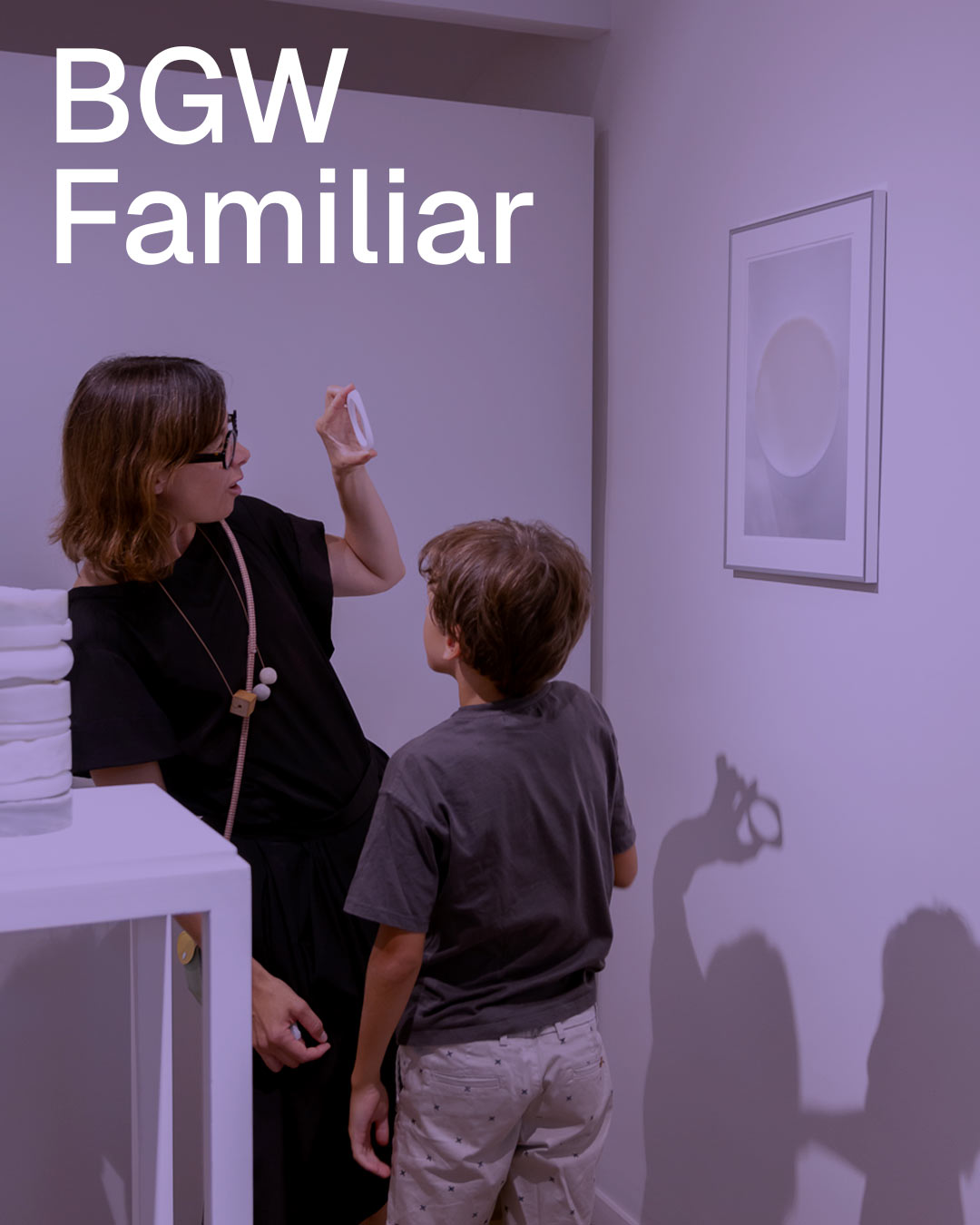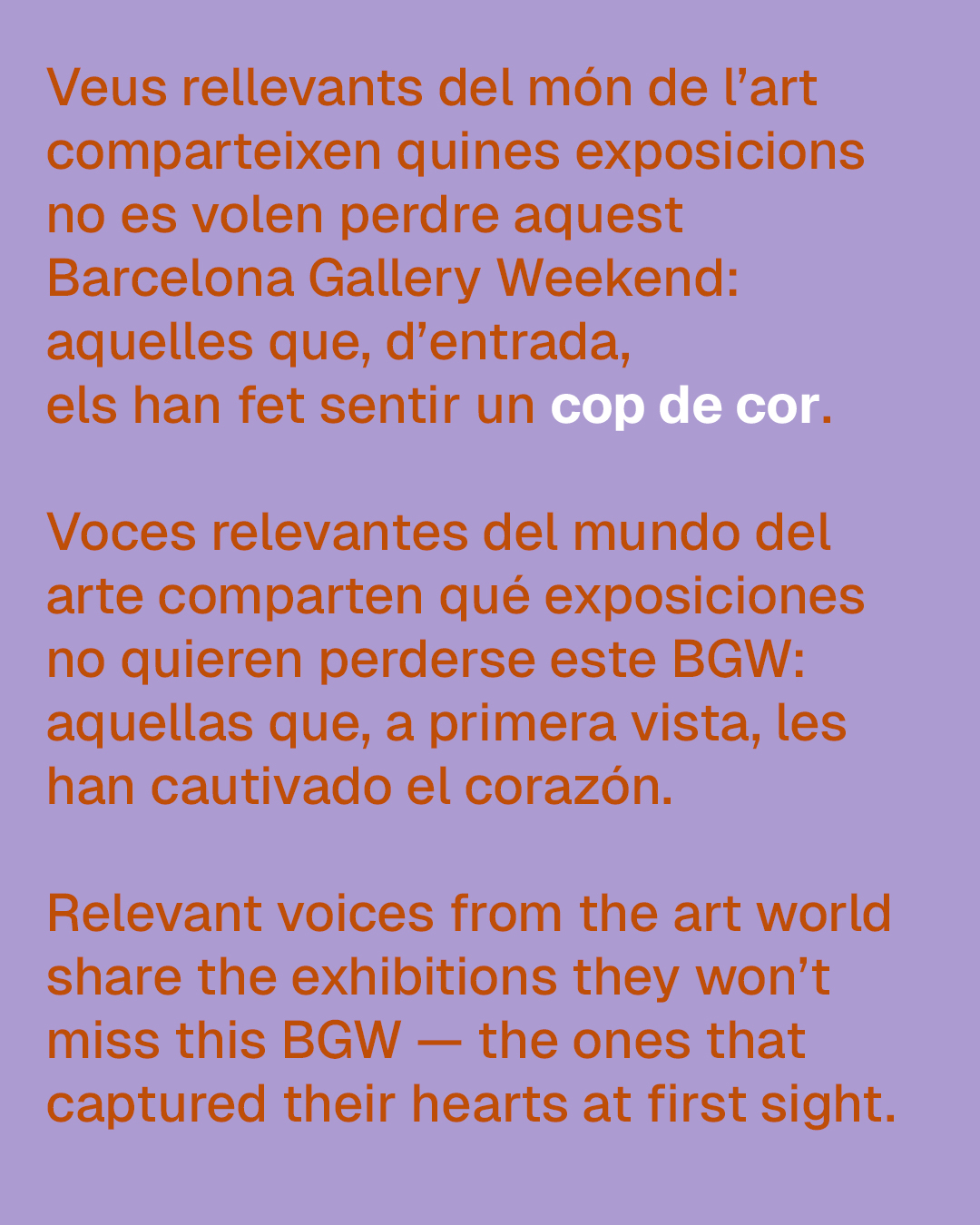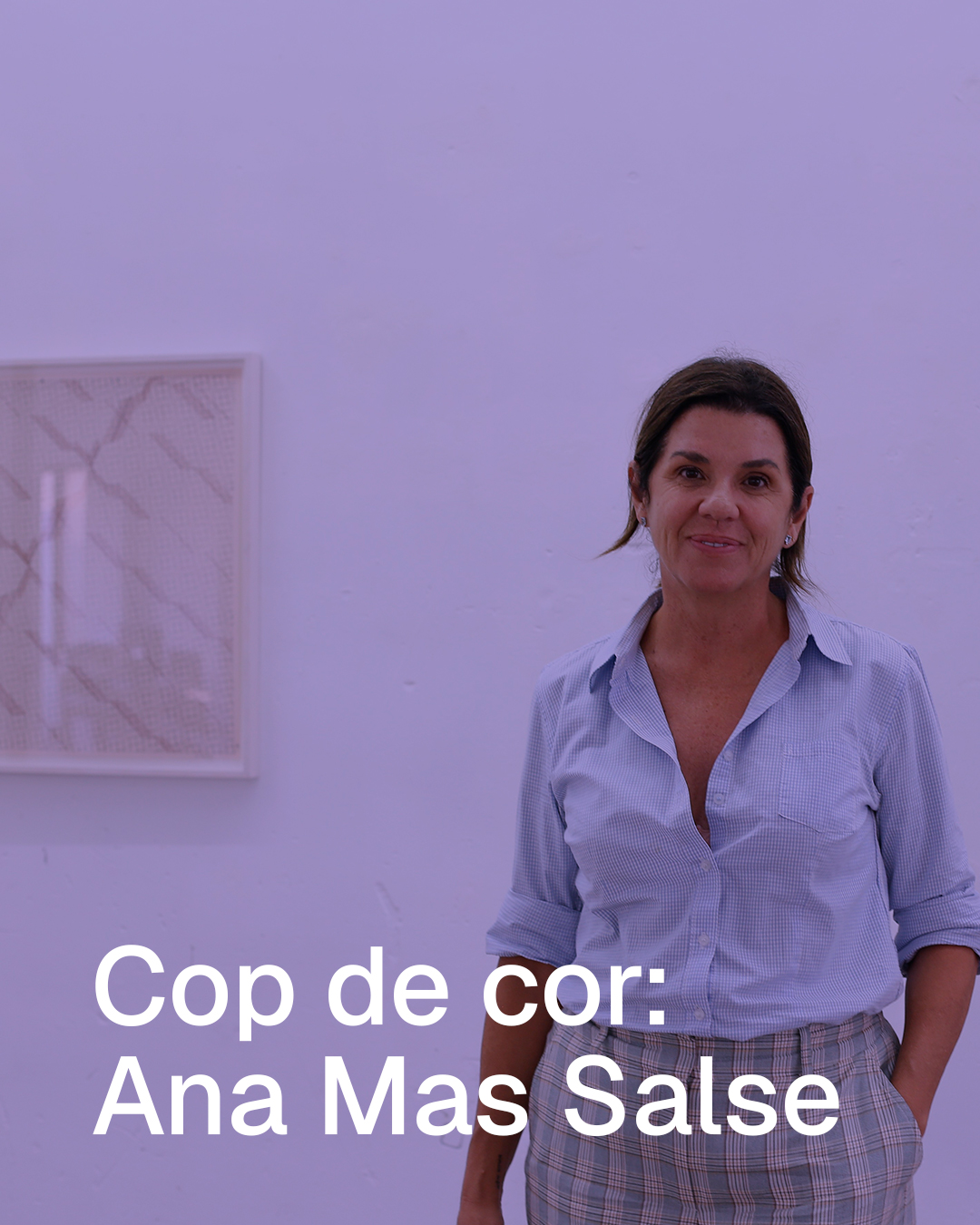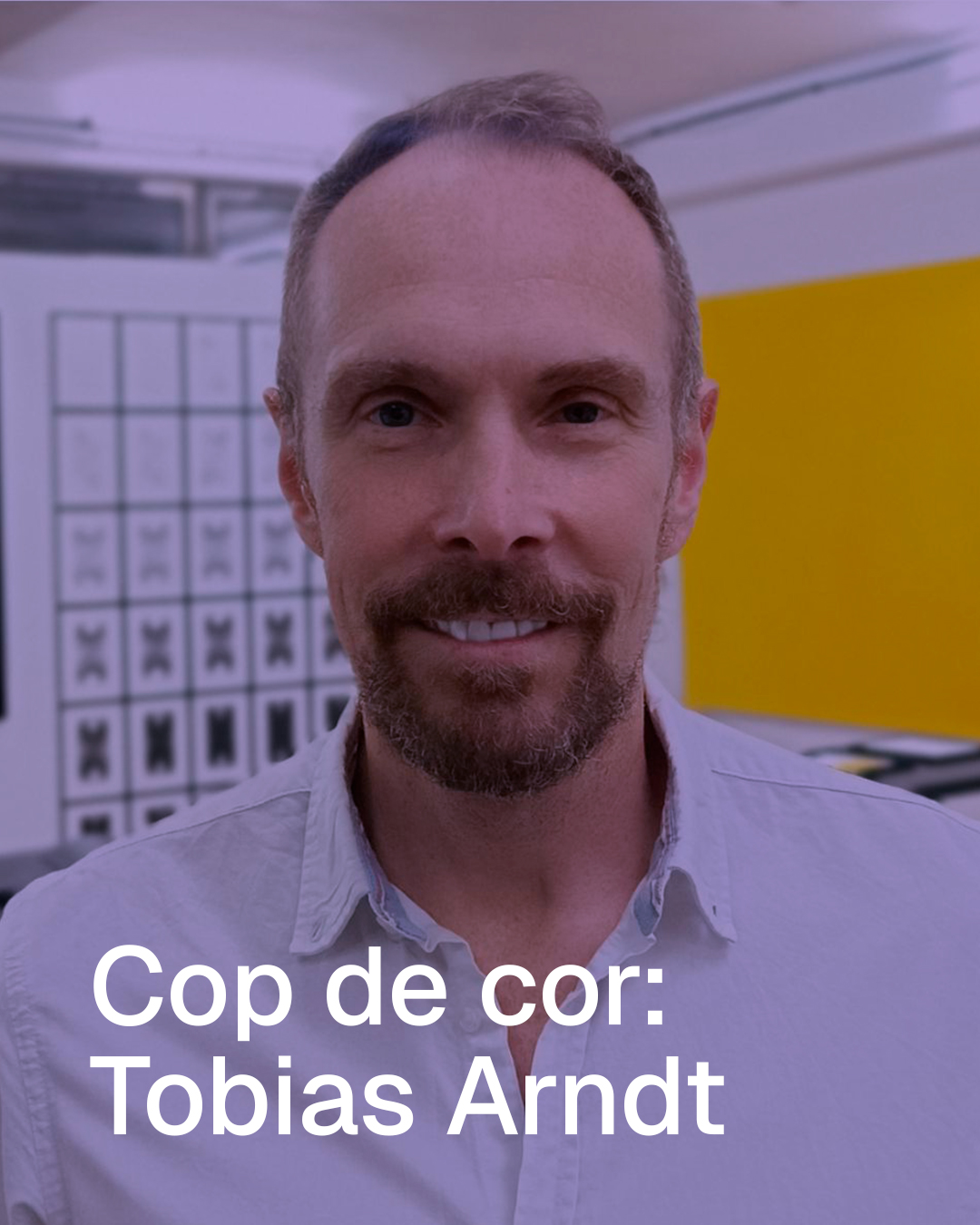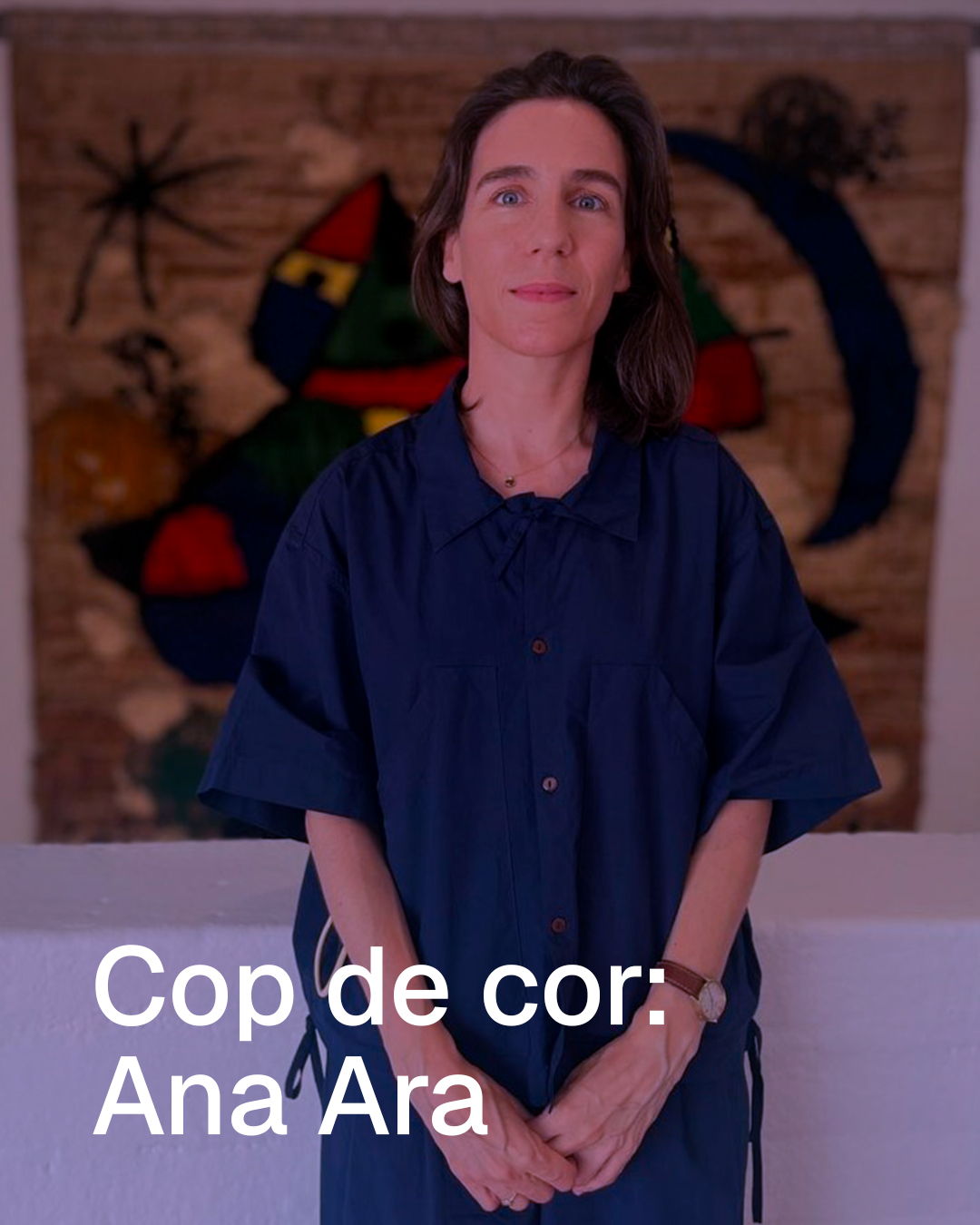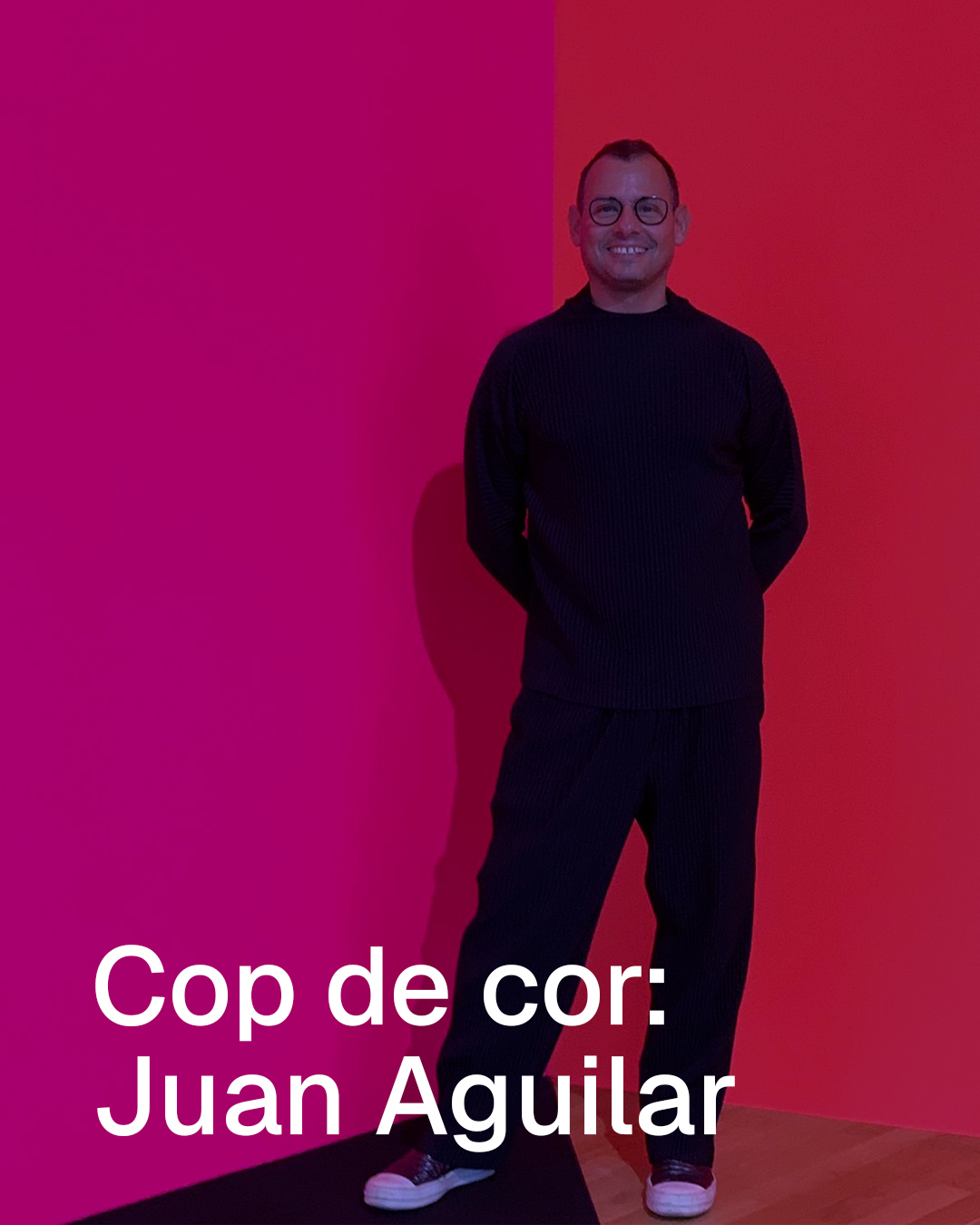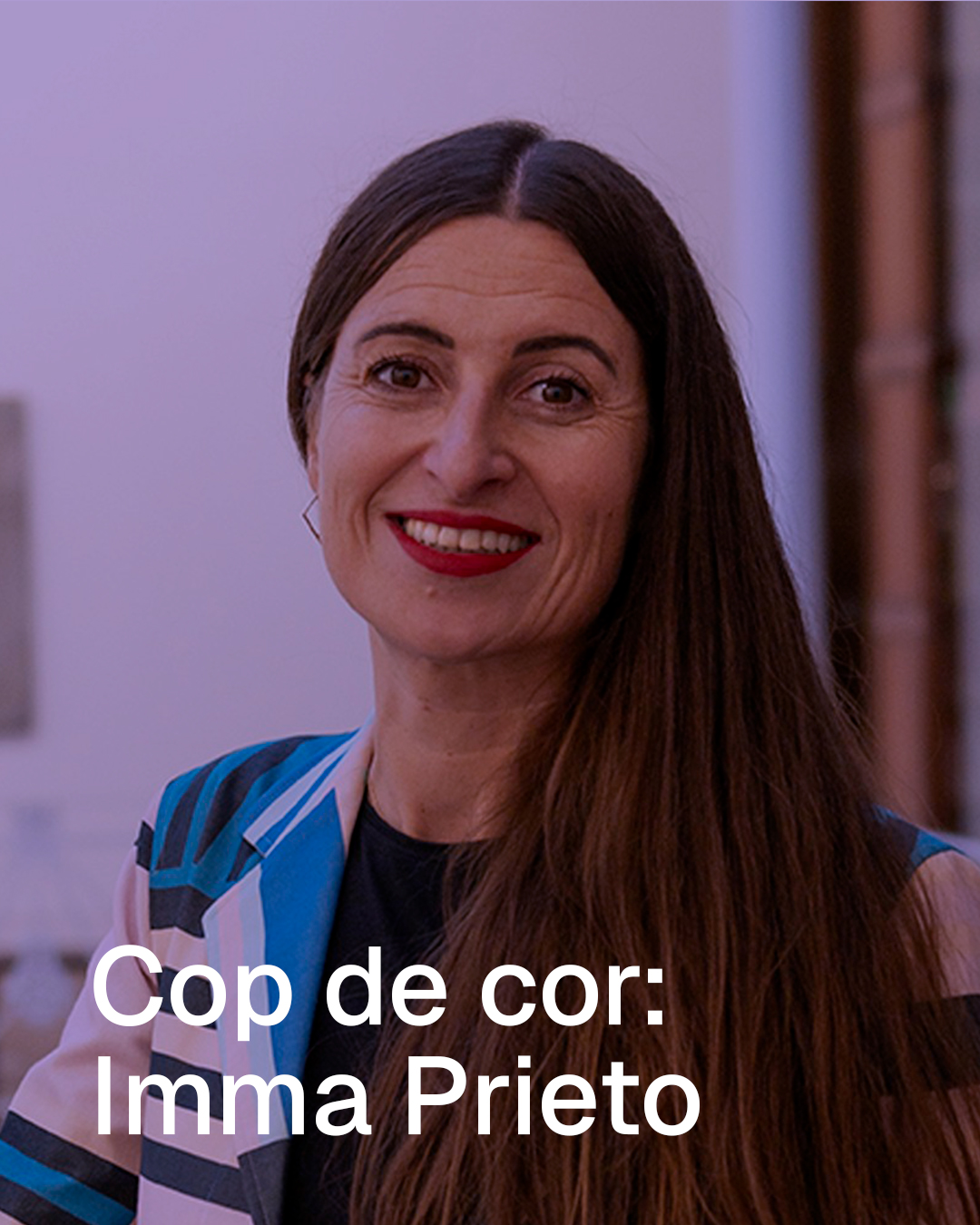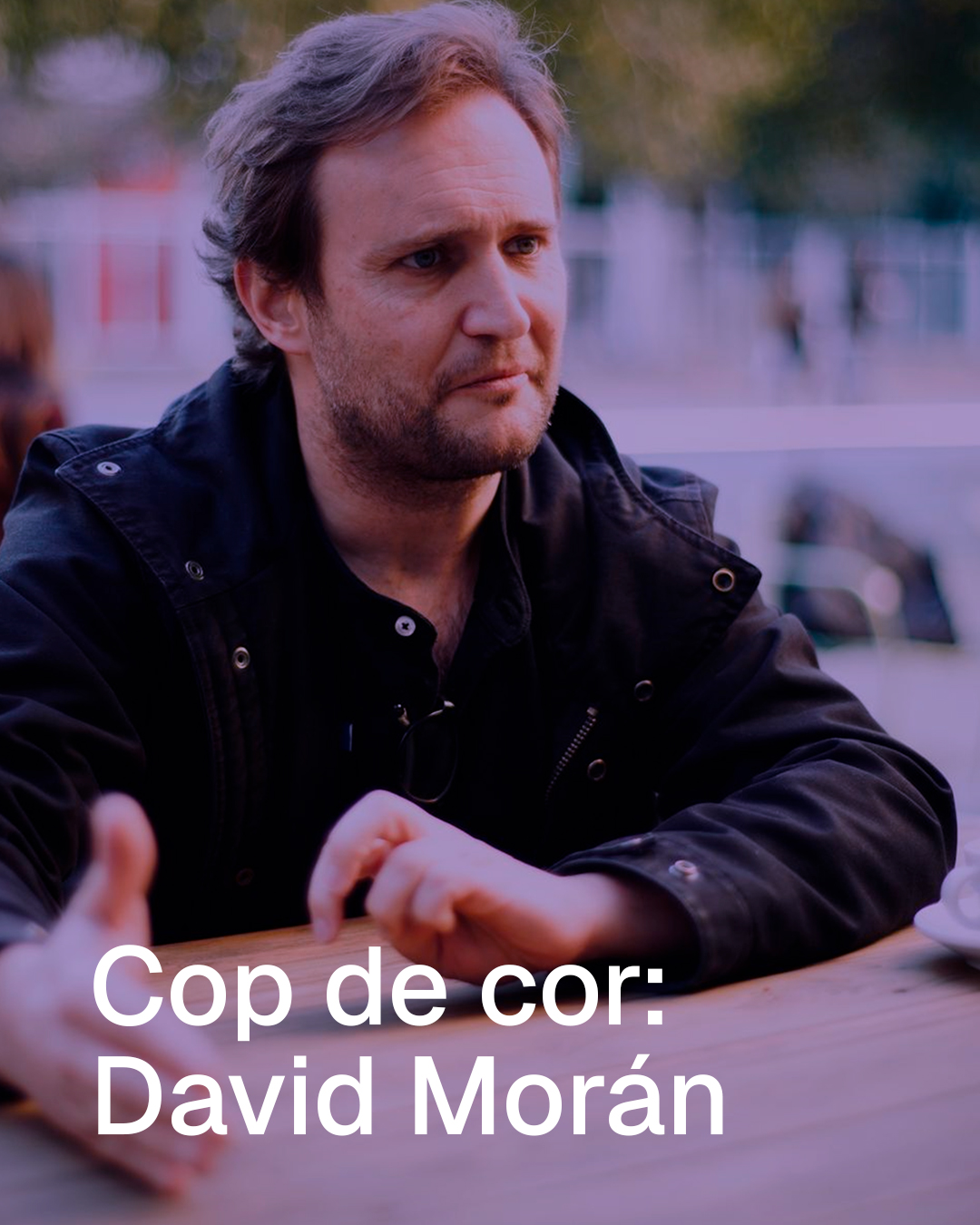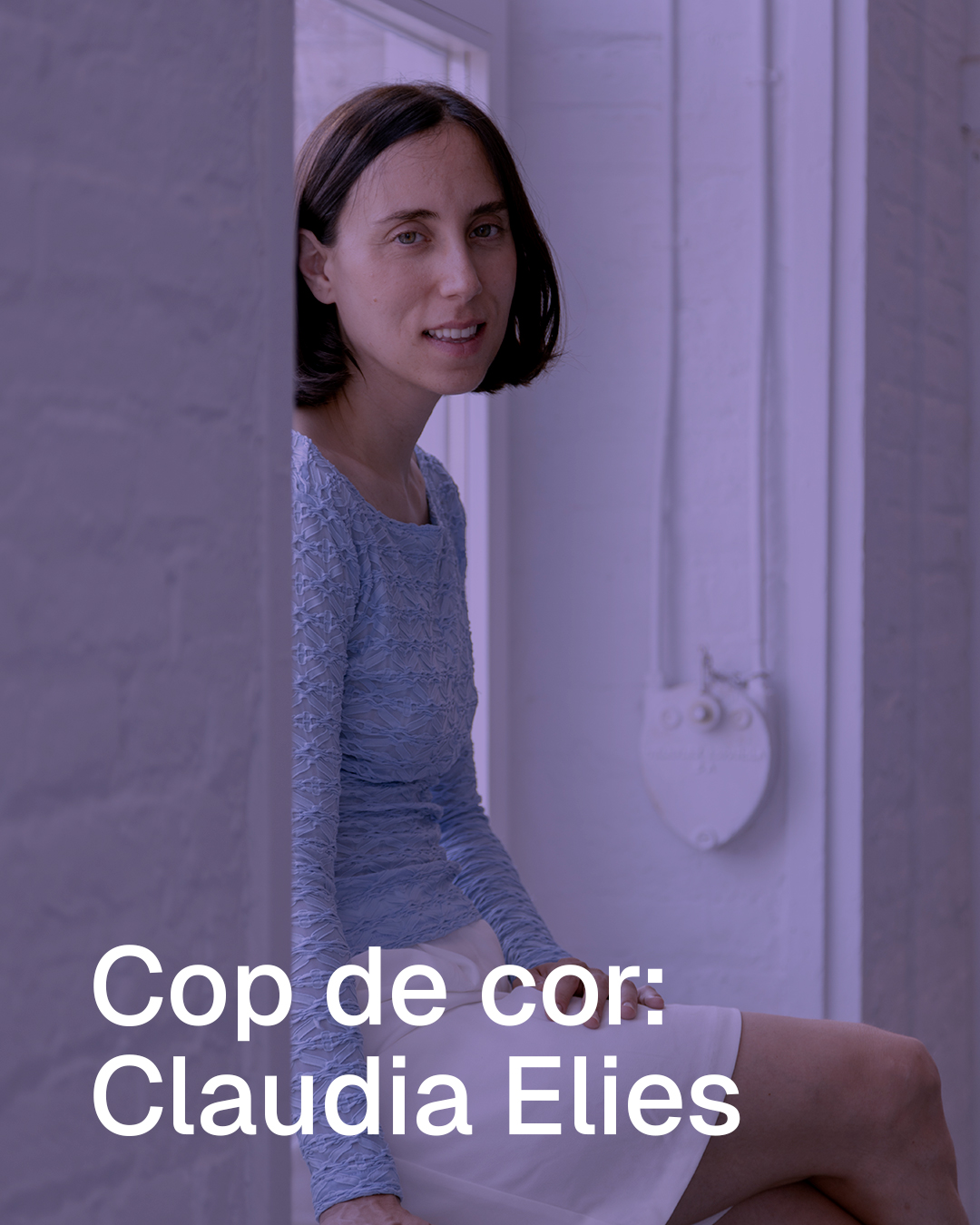ARCO GalleryWalks
With the collaboration of Fundación ARCO, Barcelona Gallery Weekend offers guided tours to the participating galleries led by professionals from the local context. These walks will provide a first-hand insight into the work of the galleries and their artists, bringing the public closer to current artistic creation.
The 16 itineraries will take place on 21st and 27th September, and at the end of each route we will share a BCNMUT vermouth courtesy of BCN Spirit.
In Catalan / Spanish. Limited capacity. Previous registration required (links below in each tour):
Reservations: Sunday, September 21st:
11:00 AM: L’Hospitalet: Galería Alegría, ethall
11:00 AM: Sant Antoni — Ciutat Vella: Chiquita Room, àngels barcelona, Sala Parés
11:00 AM: From Aribau to Passatge Mercader: Victor Lope Arte Contemporáneo, ADN Galeria, Palmadotze
11:00 AM: Trafalgar 1: galeria SENDA, FUGA, Prats Nogueras Blanchard, Taché Art Gallery
11:30 AM: Gràcia a l'Eixample: House of Chappaz, Suburbia Contemporary, RocioSantaCruz
12:30 PM: L’Hospitalet [bis]: ethall, Galería Alegría
1:00 PM: Passatge Mercader: ProjecteSD, Zielinsky, Galeria Marc Domènech
1:00 PM: From Passatge Mercader to Aribau: Palmadotze, ADN Galeria, Victor Lope Arte Contemporáneo
1:00 PM: Trafalgar 2: Pigment Gallery, Dilalica, Bombon Projects
Reservations: Saturday, September 27th
11:00 AM: Trafalgar 1 [bis]: galeria SENDA, FUGA, Prats Nogueras Blanchard, Taché Art Gallery
11:00 AM: Consell de Cent: SELTZ by Ritter Ferrer, 3 Punts, Mayoral
11:00 AM: Passatge Mercader [bis]: ProjecteSD, Zielinsky, Galeria Marc Domènech
11:00 AM: Sant Antoni — Ciutat Vella [bis]: Chiquita Room, àngels barcelona, Sala Parés
11:30 AM: Gràcia a l'Eixample [bis]: House of Chappaz, Suburbia Contemporary, RocioSantaCruz
1:00 PM: Consell de Cent [bis]: Mayoral, 3 Punts, SELTZ by Ritter Ferrer
1:00 PM: Trafalgar 2 [bis]: Pigment Gallery, Dilalica i Bombon Projects
*Photo: Galería Alegría, BGW2024. Rafael Arocha.
Itineraries
BGW Familiar
Visits for families with children to a selection of exhibitions of Barcelona Gallery Weekend 2025 programme.
Curator Alexandra Laudo [Heroínas de la Cultura] will lead the participants to reflect on what they see through questions, games and other proposals.
Sunday, 21st September, 11:00 — 11:45 am
Palmadotze - pop up in Barcelona
Susanna Inglada: It's you.⚡
Sunday, 21st September, 12:30 — 13:15h
ADN Galeria
Carlos Pazos & Georges Brecht: La paradoja del no.⚡
Saturday, 27th September, 11:00 — 11:45h
Prats Nogueras Blanchard
The Architecture of the Unbuild. Christo and Jeanne-Claude's unrealized projects.
Recommended age: from 6
In Catalan / Spanish.
Free admission with previous registration (limited capacity): bgw@artbarcelona.es
*Picture: BGW Familiar at Chiquita Room during BGW2023. Eva Carasol.
Ana Mas Salse, gallerist and collector.
Relevant voices from the art world share the exhibitions they won’t miss at this year’s Barcelona Gallery Weekend — the ones that captured their hearts at first sight.
The dreamlike and spiritual world of Josefa Tolrà at Bombon Projects —a singular, visionary artist and medium. A universe unfolded in her notebooks, beautiful embroideries and drawings.
The dialogue between Bruno Munari and Mari Chordà at Chiquita Room — two artists whose work I deeply admire — in a fantastical encounter where playfulness interacts with the world.
Julia Spínola and her sculptural work at ethall: I have no doubt she will develop an intriguing site-specific proposal within the gallery space.
Discovering the unrealized projects of Christo and Jeanne-Claude at Prats Nogueras Blanchard, an expansive display of the meticulous preparation process: models and drawings, engineering studies, bureaucratic documents. Even though they were never built, they still existed, in their own way.
The symbolic representation of nature in the pictorial compositions of Carlos Forns at Sala Parés.
Marcelo Brodsky at Zielinsky and his work as an artist and activist, who unfolds through intervened photographic series an alternative form of visual and conceptual language. From private memory, he tells collective stories rooted in impactful historical events.
Tobias Arndt, collector.
Relevant voices from the art world share the exhibitions they won’t miss at this year’s Barcelona Gallery Weekend — the ones that captured their hearts at first sight.
On the parcours, I would like to propose the work of Ken Sortais (Galería Alegria), that perhaps gets closest to painting. I am familiar with his sculptural works that often have a playful element and research the relationship between colour and shape and evoke confusions about materiality. I am very curious to experience the wall pieces.
This leads me to Raisa Maudit (House of Chappaz) that often centres around video (or is it simply my view as a video collector?) interacting with other media performance, scenography, text and 3-dimensional elements and also do not lack playfulness. Her trans-feminist view and different narratives highlight questions that imperatively demand a positioning.
Regina José Galindo and Avelino Sala (ADN Galeria) propose a dialogue where feminism including trans-feminism becomes or better is existential. The unimaginable brutality of femicides in José Galindo’s home country Guatemala mark her work. I was recently deeply touched by her performance and photo works jardins de flores (2021) where 25 trans women were covered under colourful fabrics and kept motionless virtually forming a flower garden. I am looking forward to her dialogue with Avelino Sala’s 'this machine kills fascism'.
Itziar Okariz (Flash⚡/ethall) also manifests motionless in her video work at ethall. It shows a fragment of a body with a pen written sign. The person tries to remain motionless simulating a still image. For me this work constitutes a key piece in Okariz practice producing meaning through emphatic reiterations of signs or language. While not appropriating the label feminism as too tight, her work does research critiques of normative gender constructions.
This inevitably leads to Eva Fàbregas (Bombon Projects) who unites gender topics in literally the most playful way. Her oversize sculptural depictions of intercourse devices or remains (used condoms) invite to take a more relaxed approach e.g. by sitting or stretching out on them and getting ready for drinks after a long art day.
Ana Ara, Artistic Director at the Joan Miró Foundation.
Relevant voices from the art world share the exhibitions they won’t miss at this year’s Barcelona Gallery Weekend — the ones that captured their hearts at first sight.
3 interesting artists worth following closely in 3 must-visit galleries in the city:
Julia Espínola at ethall, Ariadna Guiteras at Dilalica and Eva Fàbregas at Bombon Projects.
Established artists who continue to surprise, in galleries with a good exhibition programme:
Rogelio López Cuenca (Málaga, 1959) at àngels barcelona and Josefa Tolrà (1880-1959) at Bombon Projects.
Juan Aguilar, collector.
Relevant voices from the art world share the exhibitions they won’t miss at this year’s Barcelona Gallery Weekend — the ones that captured their hearts at first sight.
[1] Avelino Sala and Regina José Galindo in ADN Galeria:
I love that there is Latin American content in BGW. I've seen a couple of Regina José Galindo's video performances and I really like her strong but delicate approach to a social circumstance.
[2] Eva Fàbregas in Bombon Projects:
One of my favourite artists at the moment, who needs no further presentation or introduction.
She has a very generous capacity to express herself plastically, invading spaces and the imagination. A playful, organic and even erotic proposal, while remaining a serious formal work.
[3] ProjecteSD:
My attention is currently on LUCE, captivated by the wonderful simplicity of his work, where he collects and salvages discarded, forgotten, time-worn objects and gives them new meaning. I wouldn’t miss this show.
Silvia, the gallerist, has a very special eye—without fanfare and often without bold colors. She presents wonderful proposals and artists with extraordinary sensitivity and strong, thoughtful concepts.
This is the case with Hans-Peter Feldmann, who, throughout his artistic career, showed the system that a work should be valued for what it is—for the idea it conveys, not the size of its edition. He had a very unique way of approaching memory: rescuing it, laughing at it, and reimagining it.
[4] Giovanni Ozzola at Suburbia Contemporary:
I believe there’s something nostalgic that draws me to this show. The combination of the ephemeral nature of the objects presented in the images—taken across different geographies—symbolizes life itself: wear, the passage of time.
[5] Marcelo Brodsky at Zielinsky:
I am passionate about the rescue and research work of these gallerists, as well as the fact that they bring non-traditional artists or those who don't necessarily correspond to their own scene, which is something to be grateful for.
[6, 7, 8, 9...] Javier Pérez at Taché Art Gallery I won't miss it for anything, I'm curious about Bruno Munari and Mari Chordà's show at Chiquita Room, at ethall will be the first show I visit of Itziar Okariz, and it will be a nice opportunity to see the work of the wonderful duo Christo & Jeanne-Claude at Prats Nogueras Blanchard.
Imma Prieto, Director of the Museu Tàpies
Relevant voices from the art world share the exhibitions they won’t miss at this year’s Barcelona Gallery Weekend — the ones that captured their hearts at first sight.
[1] At Bombon Projects, Eva Fàbregas and Josefa Tolrà:
Interesting dialogue between past and present through the materialisation of the invisible.
[2] In àngels barcelona, Rogelio López Cuenca:
One of the current references regarding a critical perspective on the use of language.
[3] At Dilalica, Ariadna Guiteras:
Binomial body and action, reflection from thinking presence in relation to matter and memory.
[4] In Palmadotze, Susanna Inglada:
Dialogue between the theatrical or scenic trace and drawing as a minimal gesture of representation.
[5] At ethall, Julia Spínola and Itziar Okariz:
Reflection on the normativity of the space in wich the body is inserted, whether human or sculptural.
[6] At Chiquita Room, Bruno Munari and Mari Chordà:
A non-obvious duo based on the link between two iconic figures.
[7] At ProjecteSD, LUCE:
One of the most lucid investigations into public and urban space, and the mechanisms that are activated or deactivated when it comes to communication.
David Moran Alvarez, Editor of La Dominación Mundial and collector.
Relevant voices from the art world share the exhibitions they won’t miss at this year’s Barcelona Gallery Weekend — the ones that captured their hearts at first sight.
[1] Julia Spínola. El Vuelto. ethall.
Risk, subtlety, chance, and forcefulness are some of the qualities that connect an artist like Julia Spínola with a space like ethall. Knowing the artist’s previous work and the gallery’s trajectory, we expect to feel the vertigo of the unseen. The unpredictable is always a condition — and not the least — of desire. The most anticipated exhibition.
[2] Josefa Tolrà. Deixa’t créixer les ales. Bombon Projects.
Seeing the work by Josefa Tolrà at Bombon Projects is one of those perfect coincidences that promise revelations. The artist, a key figure in mediumistic art in Catalonia, will find in this gallery — known for its ability to offer new readings — the ideal space for us to rediscover the power of her visionary work. One of the unmissable dates in this year’s cultural calendar in Barcelona.
[3] Bruno Munari / Mari Chordà. Lullaby to Wake up a Baby Girl. Chiquita Room.
After Mari Chordà’s revelatory exhibition at MACBA, her dialogue with Bruno Munari promises to be fascinating. Chiquita Room’s sensitivity in weaving connections between art, design, and poetry makes this encounter one of the most tempting proposals of BCN Gallery Weekend. The conjunction of two artists who have explored creative freedom through pedagogy and visual poetics could not find a better setting.
[4] La paradoja del No. Carlos Pazos / Georges Bretch. ADN Galeria.
The encounter between Carlos Pazos and Georges Brecht at ADN is one of those proposals that spark curiosity from the very premise. It is a meeting as stimulating as it is unexpected. The overlaps and displacements that may arise from this impossible conversation are reason enough not to miss this exhibition.
[5] Searching where there is nothing. LUCE. ProjecteSD.
I don’t know if LUCE is the most gifted urban artist in our country, but he is certainly the only one who can lay claim to a poetics as broad as it is subtle. His ability to read the city and transform it through interventions as precise as they are lyrical finds the perfect framework for development in this gallery. The promise of seeing how he translates his unique way of understanding urban space into the exhibition context makes this show a key date in the event’s agenda.
Photo: Miguel de Guzmán.
Claudia Elies, Director of La Fabra Centre d'Art Contemporani.
Relevant voices from the art world share the exhibitions they won’t miss at this year’s Barcelona Gallery Weekend — the ones that captured their hearts at first sight.
[1] Bombon Projects – Deixa't créixer les ales - Josefa Tolrà – Curated by Pilar Bonet
Pilar Bonet has spent a lifetime observing the work of Josefa Tolrà, and each time she has something more to tell us. I'm always drawn to these figures who, like editors, accompany an artist throughout their entire life. I also sense that the dialogue she will create with the work of Eva Fàbregas will be especially interesting.
[2] Chiquita Room – Mari Chordà and Bruno Munari – Curated by Àngels de la Mota.
Because it not only means getting to see Bruno Munari’s work in Barcelona, but we’ll also experience it through the eyes of Àngels de la Mota, who is capable of imagining an encounter between the Italian artist and Mari Chordà.
[3] ethall – El vuelto – Julia Spínola.
The image of the exhibition, somewhere between delocalized and decentralized, gives me that strange feeling that makes me want to keep looking. I also don’t need any excuse to go see whatever Julia Spínola is doing.
[4] Galeria Marc Domènech – Palencia vs. Serzo. Prelude to a III Escuela de Vallecas – Benjamín Palencia and José Luis Serzo.
I am very curious to see those open spaces and barren lands that once inspired so many artists. Places that have now become new urban stages, cleared of old warehouses and re-inhabited by contemporary artists.
[5] Prats Nogueras Blanchard – The architecture of the unbuilt. Christo and Jeanne-Claude’s Unrealized Projects – Christo & Jeanne-Claude.
It’s a chance to see what we normally don’t see, what remains buried under a pile of papers in a studio, and and that often only belongs to the intimacy of the artist or his/her narrowest circle. And also because it’s a chance to see –– finally –– the Columbus monument covered.
[6] ProjecteSD – Searching Where There Is Nothing – LUCE.
Just from the title alone, I imagine we’ll be able to discover details of things that have always been there but that we’ve never known how to stop and truly observe. I sense a journey through what goes unnoticed, as if we could become the camera that sometimes LUCE wears on his helmet.
